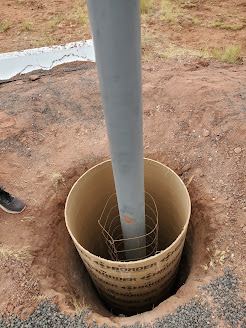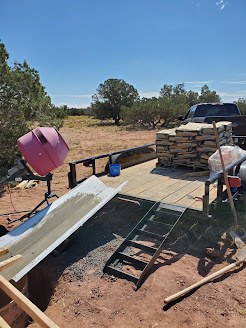Sometimes you don't know something exists until you need it. When we started looking for a solar water heater we saw a couple different systems, but we really thought the Sunbank residential solar water heater was the perfect solution. Having dealt with the company for a few months now I can attest that the customer service is excellent and James, who appears in their YouTube videos, is responsive via email and super helpful with technical questions.
The system is sent via freight from California and it is clear that the freight drivers don't give two shits about how the packages arrive. We ended up with one broken tube and a number of bent heat pipes. Apparently it is really hard to ship these things because the replacements ended up broken as well and we took a refund for the broken glass. Thankfully this system does not need all of the tubes to create hot water. (at least in AZ)...but I am getting ahead of myself.
The installation starts with building the aluminum frame - here it is in a very preliminary stage.
Once it is put together you add the 40 gallon tank:
Plumbing this sucker ended up being a bit more challenging that I thought it would be. I planned on using Pex because, well, I don't know how to sweat copper, but Pex can only handle temps to 180 degrees Fahrenheit. So we spent a lot of time considering how to ensure we don't overheat the water. Our short-term solutions is to only use half of the tubes. With half of the tubes our water is around 100 degrees F - this allows for a very comfortable shower.
We did run into a few issues when plumbing this. I had an older manual I downloaded from the Sunbank website and I purchased the items to insulate the lines based upon that manual. In an email with James he gave me the newest manual and they had changed their recommendation about how to insulate - but I had already bought the items....so we tried it and learned why they changed their recommendation.
The old recommendation was to use ducting which you can see in this picture. It is hanging away from the tank while we connected the hot and cold lines.
So we had everything connected, thread sealed and pipe doped - and then we tried to "slide" the duct up over the lines to attach it to the tank....and we created leaks by shaking the lines. It was SO frustrating. We had to cut off both lines, I had to figure out how to get the crimped Pex rings off and we had to redo the whole thing.
In the end we used the new recommendation of insulation and it looks like this:
From the front:
Of course we are in Northeast AZ and get full sun much of every day - we are going to add a couple more tubes and see how that changes the temperature of the water. We know in the winter we will likely need all of the tubes. James from Sunbank recommends a method of painting half of the tube and then rotating them depending on the time of year.
I think we will go this route eventually - just have to find the time for this project! For the time being using fewer tubes is working great!
A part that was not easy to find was a mixing valve. I just received it yesterday. This will protects people from scalding themselves when running the hot water inside. Of course we know our hot water is only at 100 right now, but if we add tubes it will get hotter. The mixing valve keeps the water coming into the house at 120 degrees by mixing the hot with the cold line. I have some concerns about installing it because I will not know how hot it is getting so I am going to wait a bit and experiment with more tubes first.
The mixing valve will be installed in this valve box:
It is not buried yet and the connections look like this:
It's hard to see, but this is where I have the shut offs for the hot and cold and I added a hose bib on our pressurized line. The valve box will also be full of insulation for the winter.
Overall this has been a challenging project, but I am so happy to be showering in hot water from the sun! While this may not be the best system for all locations, it is certainly working well for us. Many people use the Sunbank as a pre-heater to their conventional system. We do not have a conventional system at all. The test of this system (for us) will come during the winter!











































